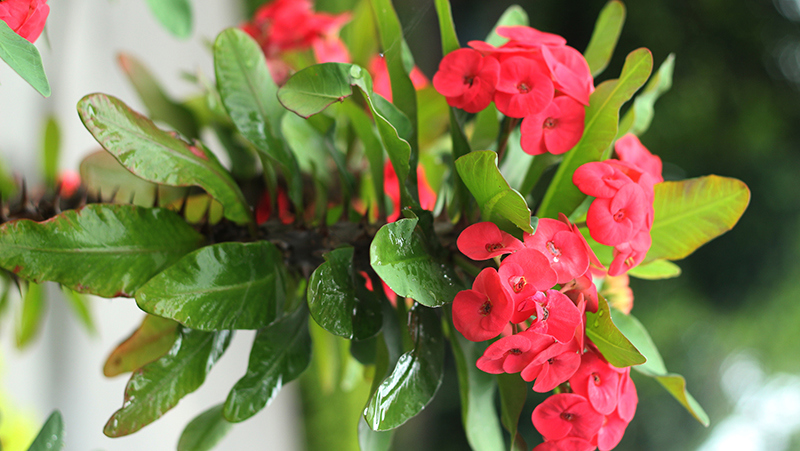Yates Account
Join now
Create a Yates account today!
Sign up to join the Yates Garden Club for monthly e-mails packed with seasonal inspiration, tips for success & exclusive promotions.
Plus if you’re a Garden Club member you can take part in the Yates Growing Community - a blog to share successes, get advice & win prizes in fun challenges along the way!

Forgot password
Enter the email address associated with your account, and we'll email you a new password.

How to grow Euphorbia in a garden
- Choose a position in full sun or part shade with very well drained soil. Avoid planting clayey soils, however, if you wish to persevere, add gypsum and fork in well. The addition of sand and coconut fibre may also help to open up the soil more.
- Enrich the soil with Yates Dynamic Lifter Organic Plant Food.
- Dig the planting hole twice as wide and to the same depth as the root-ball. Remove the plant from the container and gently tease the roots.
- Position in hole and backfill, gently firming down. Form a raised ring around the plant, creating a well so that water will go where it’s needed most. Water in well.
- Mulch lightly (5cm depth) with an organic mulch like woodchip or pea straw, keeping it away from the base of the plant.
- Water deeply, once or twice a week, depending on weather conditions.
- During the growing and flowering season feed with Yates Thrive Rose & Flower Granular Plant Food. TIP: for an added boost apply Yates Thrive Roses & Flowers Liquid Plant Food.

How to grow Euphorbia in a pot
- Choose a pot at least 300mm wide with adequate drainage holes.
- Position in full sun or part shade.
- Fill pot with a good-quality, free-draining potting mix, such as Yates Thrive Cacti & Succulent Potting Mix.
- Remove the plant from the container and gently tease the roots.
- Position in hole and backfill, gently firming down.
- Water in well.
- Water deeply, once or twice a week, depending on weather conditions.
- During the growing and flowering season, apply Yates Thrive Roses & Flowers Liquid Plant Food. Throughout the year apply Yates Thrive Fish Blood & Bone Plant Food Concentrate.
Growing tips
-
Take care when pruning as the plant produces a poisonous milky sap when cut. Always wear gloves and goggles when pruning and keep children and pets away too until the sap has stopped dripping.
- Pests are known to keep well away from these plants due to their sappy nature.
- Prune regularly after flowering to keep the plants in shape.
- Euphorbias are great for the Mediterranean type garden or dry garden bed.
- There are many different species and cultivars of Euphorbia. The most common of them are:
Crown of Thorns (E. milii)
As the name suggests, this species is a little thorny (pretty-but-prickly) but produces the loveliest delicate flowers in the warmer months of the year. They can grow up to 1.5 metres if left to their own devices. Often seen in baskets or pots, just be sure to wear protection when pruning to avoid getting caught up in their thorns!
Mediterranean Spruge (E. characias ssp. wulfenii)
Much loved for the cottage garden, this rounded shrub produces outstanding blue-green foliage on upright stems. Flowers appear from late winter to spring that stand tall above the foliage with their large heads of lime green bracts. Can handle light frosts in winter.Euphorbia Snow Flake/Hip Hop (E. leucocephela)
This is a popular Euphorbia due to its easy care nature and its abundance of delicate white flowers that appear at the top of the stems during autumn and winter. Great for planting in cottage style gardens or hanging baskets.
This species doesn’t handle the cold as well as others and is best grown in the temperate to sub tropical regions. Cut back flowering stems in early spring to promote further growth.
Creeping Spurge (E. myrsinites)
For an easy care ground cover, this species is a great choice. It can handle light frosts and hot dry weather as well. In addition to being a great ground cover they produce wonderful flowers in Spring and Summer that change colour from green to pink during the flowering season.Firesticks (E. tirucalli)
For a completely different Euphorbia, take a peek at Firesticks. This upright shrub, with its green base and red tips is a great addition and perfect feature plant for pots or gardens.
Best for the temperate to sub tropical climates as they don’t handle frosts due to the tender stems.Poinsettia (E. pulcherrima)
This popular Christmas plant also belongs to this wonderful family. Easy care, loves full sun and provides wonderful coloured bracts in the winter, when planted in the garden.
















Share
Share this article on social media